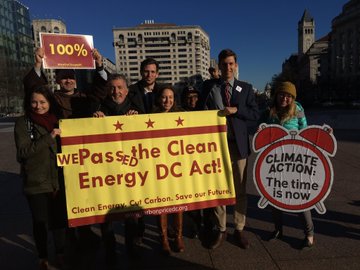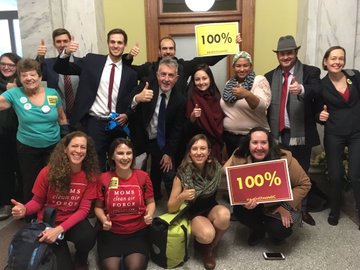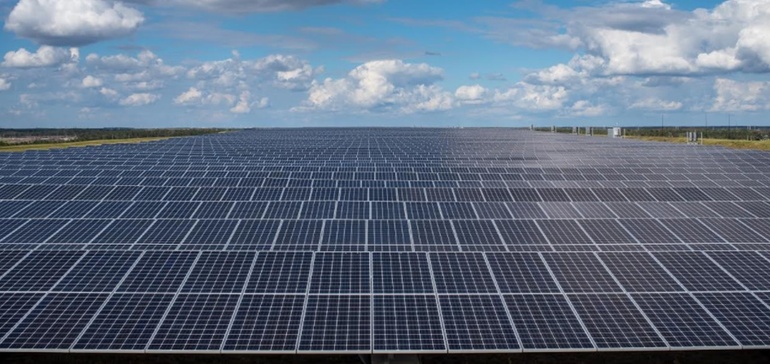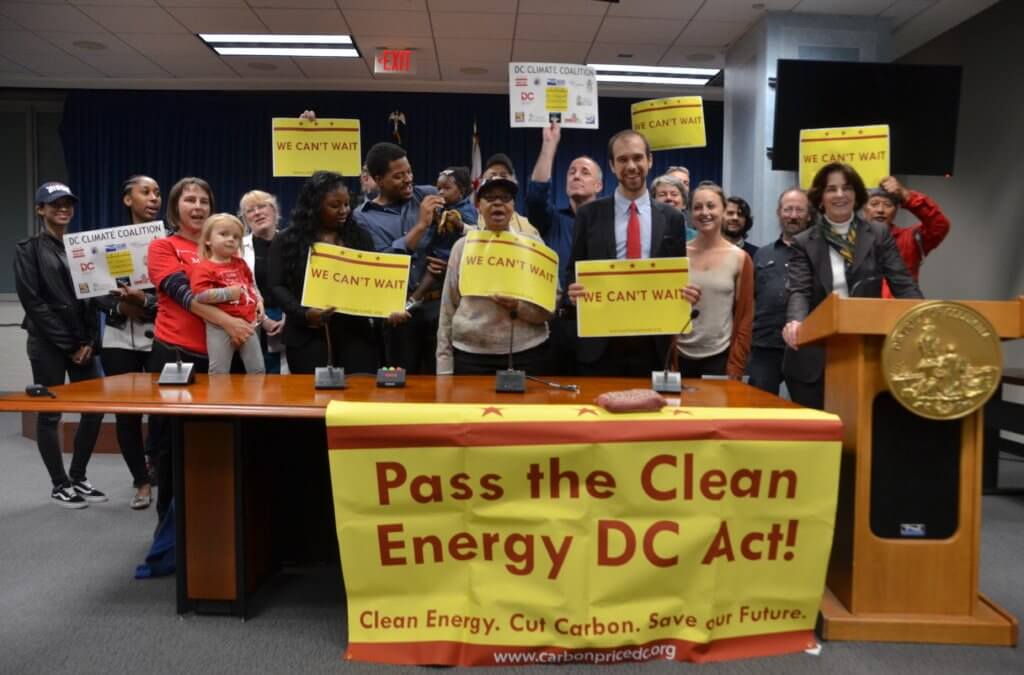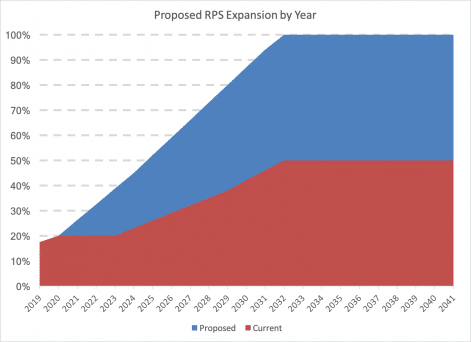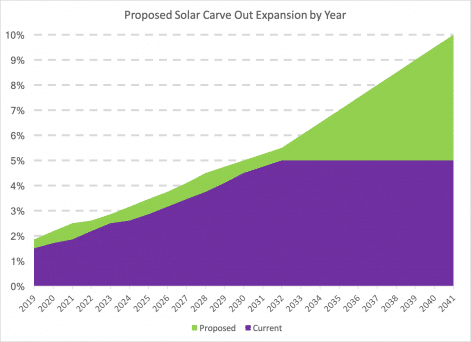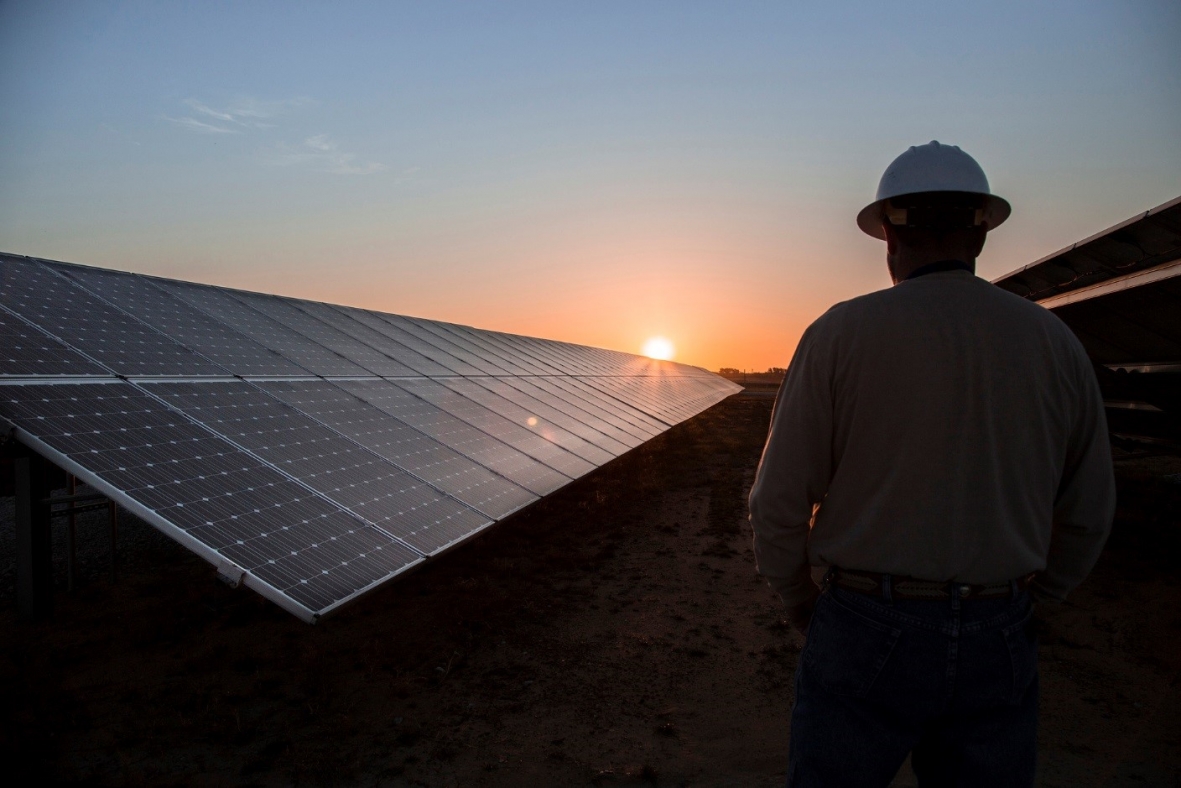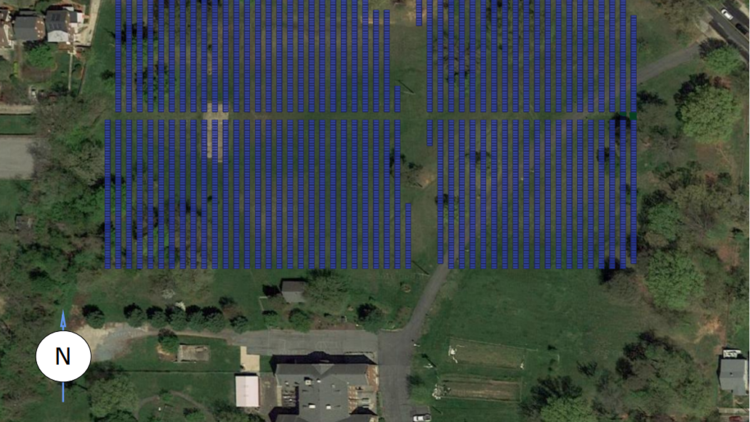IN NATION’S CAPITAL: GROUNDBREAKING “OMNIBUS” CLIMATE STATUTE ALSO CREATES DRAMATIC BUILDING EFFICIENCY STANDARDS, INCENTIVIZES ELECTRIC CARS, FUNDS A “GREEN BANK,” AND INVESTS IN SOLAR AND WEATHERIZATION FOR LOW- AND MODERATE-INCOME RESIDENTS
WASHINGTON – In the wake of alarming federal and international climate reports, elected leaders of the District of Columbia — representing nearly 700,000 people in the nation’s capital city — today gave final approval to a bill to mandate 100 percent of the city’s electricity come from clean renewable power by the year 2032. This represents the strongest legislative mandate of its kind of any state in America.
The “Clean Energy DC Omnibus Act of 2018” also creates enormous incentives for electric cars, sets groundbreaking efficiency standards for existing buildings, and expands a pollution fee on electricity, natural gas and home-heating oil. It then invests that carbon revenue in a special “Green Bank” for clean energy loans and efficiency and solar programs for low and moderate income residents..
“After the Trump Adminstration’s shameful performance at the Poland climate talks, this bill in the nation’s capital is a real beacon of hope,” said Mike Tidwell, Director of the CCAN Action Fund, a sister group of the Chesapeake Climate Action Network. “This bill was two years in the making, and involved everyone from neighborhood moms to top business leaders to champions on the DC Council. We’re going to send clean energy to the White House and members of Congress whether they’re ready for it or not.”
CCAN Action Fund extends special thanks to Councilmember Mary Cheh (D-Ward 3) for her dogged leadership in working with advocates to write this bill and seeing it through the legislative process from start to finish. And thanks to Councilmember Vincent Gray (D-Ward 7) who as former mayor of the city set a guiding vision for action with his landmark Sustainable DC Plan. And thanks to leading supporters, including the DC Chapter of the Sierra Club, Citizens Climate Lobby, Interfaith Power & Light DC.MD.NoVa, Moms Clean Air Force, SEIU Local 32BJ, 350DC, DCEN, Coalition for a Resilient DC and many others.
“This bill should be a boost to advocates nationwide,” said Camila Thorndike, DC campaign director for CCAN Action Fund. “Finally some good news out of Washington. We did it. The people of DC ignored our delinquent federal leadership and made 100 percent renewable power a reality for our city over the next decade. If we can do it, states across America can do it too.”
The DC bill sets a very high bar for states across the country. California has set a goal of at least 60% clean electricity by 2030 and Maryland, next door, is poised to pass a 50%-by-2030 renewable electricity bill in early 2019. Both states are looking to get to 100% clean electricity soon after 2030 but have not finalized plans.
“We invite other states to set their goals very high for clean renewable power and then fight like hell,” said Thorndike. “That’s what we did in DC and what others thought was impossible is now going to happen. We are thrilled.”
The legislation also authorizes the District to put a fee on transportation fuels if Virginia or Maryland commit to the same. The bill will create efficiency standards for existing buildings, fund the new Green Bank, and boost local programs to assist low-income residents as the District transitions to more sustainable clean energy systems. It will also adjust the vehicle excise tax to incentivize clean cars and make owning dirty vehicles more expensive.
Here’s a summary of the bill’s main features
The Clean Energy DC Omnibus Amendment Act of 2018, or “Clean Energy DC Act,” is the result of more than
two years of advocacy and three months of working group meetings with environmental advocates, the
energy and utility sectors, and the business community.
If enacted, this bill would make DC a world leader on climate change. It would transition the
District to 100% clean electricity by 2032 — the strongest renewable energy bill in the country — while
investing in energy efficiency, creating groundbreaking building standards, and funding local programs to help
low-income residents and make the city a sustainable place to live.
The Clean Energy DC Act would accomplish the following:
1. Transition DC to 100% renewable energy by 2032
By increasing the Renewable Portfolio Standard (RPS) to 100% by 2032, all District electricity would come from
renewable energy like wind and solar. It also ensures that all renewable electricity is sourced from states in our
regional electricity grid, known as the PJM. This would be the strongest clean energy law in the country!
2. Increase funding for local sustainability initiatives, creating jobs and helping low-income residents By
increasing the Sustainable Energy Trust Fund (SETF) fee on fossil fuels, DC will be able to provide funding for
local sustainability initiatives. This revenue would fund the Green Bank at $15 million per year in 2020 and 2021,
and $10 million per year for the next 4 years, investing in programs that help business switch to clean energy
and create good green jobs. One-fifth of all the funds raised would be directed to programs that benefit lowincome residents, including ratepayer assistance and energy efficiency, weatherization, and fuel-switching
programs.
3. Create groundbreaking building efficiency standards
Not only does this policy create the strongest building efficiency standards in the country, it provides resources
to achieve these new standards. These standards should significantly increase efficiency and renewable jobs in
DC, while reducing the money flowing out of DC for energy imports and making DC buildings more competitive.
4. Reduce Transportation Sector Emissions
Under this policy, Mayor Bowser could commit DC to future regional initiatives that would reduce
transportation emissions and impose a carbon fee on motor fuel. It also revises DC’s vehicle excise tax to
depend on fuel efficiency, incentivizing the purchase of more fuel-efficient cars in the District.
DC can lead the way to reign in carbon emissions and bring clean energy to everyone.
Behind the Bill
There are more than 100 DC organizations and businesses supporting this bill, as part of the “DC Climate
Coalition” (formerly known as the “Put A Price On It, DC” coalition). While this coalition initially formed around
a proposal for a carbon “fee-and-rebate” policy. While our carbon pricing proposal remains the best way of
cutting carbon emissions while supporting DC’s economy and residents, the Clean Energy DC Act also strongly
positions the District as a national climate leader. This bill reflects our campaign’s hard-won principles of
strong, economy-wide emission reductions with a focus on equity.
.

